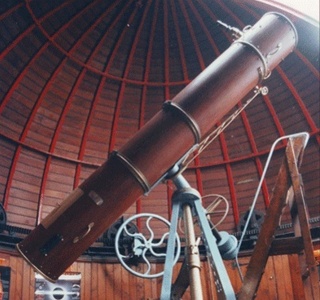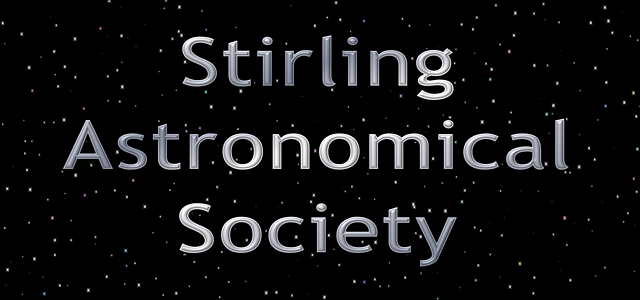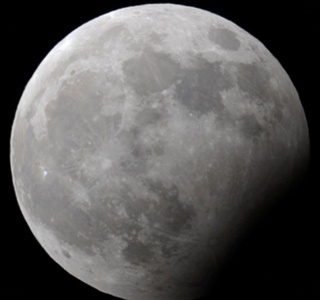Astronomy news - September 2025
21 September: Saturn at opposition
September will be the best time to see Saturn this year.
11 September: International Space Station
The International Space Station will make a number of passes in the evening during the second half of September. The ISS will be visible from approximately 21:19 to 21:22 on the 11th.
There will be further passes for the next few evenings, until 28 September.
7 September: Lunar eclipse
There will be a total lunar eclipse on the 7th September. As seen from Stirling, totality occurs just before moonrise. From 20:00 the Moon will be emerging from the eclipse as it rises.
7-30 September: Moon Phases
7 September: Full Moon (19:08)
14 September: Third Quarter (11:32)
21 September: New Moon (20:54)
30 September: First Quarter (00:53)
===== Previous News items =====
12 - 13 August: Perseid meteor shower
One of the best meteor showers of the year.
11 - 13 August : Jupiter and Venus
Jupiter and Venus will pass close to each other in the pre-dawn sky on the 11th to 13th August. Closest approach will be on the 12th, when the two planets will pass within one degree of each other.
1-23 August: Moon Phases
1 August: First Quarter (13:41)
9 August: Full Moon (08:54)
16 August: Third Quarter (06:12)
23 August: New Moon (07:06)
===== Previous News items =====
12-20 July: International Space Station
The International Space Station will be visible in Stirling skies during mid-July. The Space Station orbits the Earth approximately every 90 minutes, so most nights there will be multiple passes visible, with the first shortly before or after midnight, and subsequent passes 90 minutes later. Look for the Station moving from south-west to south-east, highest in the south. Each pass will last a few minutes.
Timings of the first pass for the next few nights:
12/13 July: 23:21 - 23:28
13/14 July: 00:09 - 00:15
14/15 July: 23:20 - 23:27
15/16 July: 00:08 - 00:13
16/17 July: 23:19 - 23:25
17/18 July: 00:07 - 00:11
18/19 July: 23:18 - 23:23
19/20 July: 00:07 - 00:08
Noctilucent clouds
The summer months are the best time to see noctilucent clouds. Noctilucents have already been seen this summer as far south as Paris, so it is worth keeping a look out.
Meteor showers
Several meteor showers will peak in July, including the Piscis Austrinid shower which peaks on the 28th July, and the Southern δ Aquariids and the α Capricornids, both of which peak on the 30th July. The Perseid meteor shower, which peaks in August, will also begin in late July, so some early Perseids may be visible towards the end of the month.
2-24 July: Moon Phases
2 July: First Quarter (20:30)
10 July: Full Moon (21:36)
18 July: Third Quarter (01:37)
24 July: New Moon (20:11)
27 June: June Boötid meteor shower
The June Boötid meteor shower, active from 22 June to 2 July, peaks around the 27th June. The best displays are likely soon after dusk, when the radiant point is still high. The peak is close to the new moon, so moonlight will be minimal. The parent body responsible for creating the June Boötid shower is the comet 7P/Pons-Winnecke.
21 June: Summer Solstice
The longest day with over 17 and a half hours of daylight.
01 June: Jeety Starn
The latest edition of the Society's newsletter the Jeety Starn is now available on the Newsleter page.
3-25 June: Moon Phases
3 June: First Quarter (04:40)
11 June: Full Moon (08:43)
18 June: Third Quarter (20:19)
25 June: New Moon (11:31)
30 May: Mercury
Mercury at superior solar conjunction, signifying the end of Mercury as a morning sky object and its shift to becoming an evening sky object for a few weeks.
08 May: Lyrid meteors
The peak of the Lyrid meteor shower (active 3 May - 14 May). The radiant in Lyra is circumpolar from Stirling, so the shower will continue throughout the night. The best display will probably be about 05:00 when the radiant point is highest.
06 May: Eta Aquariid meteors
The peak of the η-Aquariid meteor shower (active 19 April - 28 May). The radiant is in Aquarius, but from Stirling meteors may not be visible until just before 03:00, when the radiant rises above the E horizon.
05 May: Mars and Beehive
After the conjunction with the Moon, Mars will make its closest pass to the Beehive cluster (Praesepe, M44) on May 5th, passing within 37.6 arcminutes, in Cancer, becoming visible about 22:58, 33° above the Western horizon.
03/04 May: Moon, Mars and Beehive
On the evening of 03 May the six day old Moon will pass within two degrees of Mars and the Beehive cluster (Praesepe, M44). Closest approach is from Midnight on the 3rd until the Moon sets at around 02:30 on the 4th.
02 May: Vesta at opposition
Vesta (Asteroid 4) will be at opposition in Libra and visible from Stirling from about 22:58 (BST), 22° above the SE horizon. It reaches its highest point at 01:26, 29° above the horizon, with a magnitude of 5.7 and will fade around 03:26.
4-27 May: Moon Phases
4 May: First Quarter (14:51)
12 May: Full Moon (17:55)
20 May: Third Quarter (12:58)
27 May: New Moon (04:02)
01 April: Moon and Pleiades
On the evening of 01 April the three day old crescent Moon will pass in front of the Pleiades cluster, occulting several of the brighter stars. Visible from evening twilight until the Moon sets at around midnight.
5-27 April: Moon Phases
5 April: First Quarter (03:14)
13 April: Full Moon (01:22)
21 April: Third Quarter (02:35)
27 April: New Moon (20:31)
29 March: Solar Eclipse
A partial solar eclipse will take place on the 29th March. From Stirling, the eclipse will be visible from 10:05 until 12:00, with approximately 40% coverage at the maximum. Remember to take appropriate safety precautions and never look directly at the Sun.
14 March: Lunar Eclipse
A total lunar eclipse will take place on the 14th March. The full eclipse will be seen in north and south America. From the UK, only the start of the total phase will be visible, from around 05:10 until the Moon sets.
02 March: Blue Ghost lands safely
The Blue Ghost lunar lander mission touched down in Mare Crisium on the morning of the 2nd March. The first images from the lunar surface were transmitted shortly after landing, confirming that the commercially-operated lander, carrying 10 NASA scientific instruments, had landed safely on the surface.
6-29 March: Moon Phases
6 March: First Quarter (06:31)
14 March: Full Moon (06:54)
22 March: Third Quarter (11:29)
29 March: New Moon (10:57)
27 February - 2 March: Mercury, Venus and Moon
The planet Mercury is approaching greatest elongation and will be visible briefly in the evening twilight over the next few nights. From approximately 18:15 to 18:30 and in a clear sky, look for Mercury close to the horizon below the much brighter Venus. Higher up, and later in the evening, Jupiter is above the Hyades in Taurus, and Mars close to Castor and Pollux, making a total of four planets visible to the naked eye. On the 1st and 2nd of March, Mercury and Venus will be joined by a very thin crescent Moon.
9 February: Moon and Mars conjunction
The poor weather may have spoiled the view of last month's conjunction but there will be another chance this month. This month's pass, on the evening of the 9th Feb, will be even closer than last time, with the red planet almost grazing the Moon's southern limb close to Tycho and Clavius. The timing is also much more convenient, with closest approach at 19:00.
5-28 February: Moon Phases
5 February: First Quarter (08:02)
12 February: Full Moon (13:53)
20 February: Third Quarter (17:32)
28 February: New Moon (00:44)
14 January: Moon and Mars conjunction
In the early hours of Tuesday 14 January, the Full Moon will pass within half a degree of Mars. Closest approach will be at 04:20. Mars is currently at opposition so will be especially bright, making this a conjunction. In the United States, Mars will actually be occulted by the Moon, but from the UK it will still be a very close pass, within the apparent diameter of the Moon.
03-04 January: Moon Venus and Saturn
The evenings of the 3rd and 4th January will see two close conjunctions. On Friday 03 January, the crescent Moon passes within two degrees of Venus, and on Saturday 04 January, the Moon will pass in front of Saturn. Look to the West shortly after sunset on both evenings to see these conjunctions of the crescent Moon, Venus and Saturn.
01 January: First Aurora of 2025
Solar activity remains high as we start the New Year. The Aurora Borealis was seen on the evening of New Year's Day. Further activity can be expected over the first few months of 2025.
6-29 January: Moon Phases
6 January: First Quarter (23:56)
13 January: Full Moon (22:26)
21 January: Third Quarter (20:30)
29 January: New Moon (12:35)








